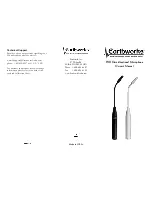
on the microphone end and a Switchcraft TA4F connec-
tor on the transmitter end, and is wired for unbalanced
low-impedance operation only (see Figure 2). Shure high-
impedance microphones are not wired to operate with
the transmitter. If a Shure high-impedance microphone
must be used, pins 2 and 3 should be reversed (by
qualified service personnel). Using a low-output, low-
i m p e d a n c e d y n a m i c l a v a l i e r m i c r o p h o n e s u c h a s
Shure’s SM11 may require raising the mixer input gain
appreciably, which in turn may result in an increase in
noise and signal “pumping.”
Instrument Connections
To connect the transmitter to a guitar or other musical
instrument pickup, obtain an instrument adapter cable
such as Shure’s WA300. This cable has a 1/4-inch phone
plug on one end and a Switchcraft TA4F on the other
(see Figure 2) and should function normally with any
high-impedance instrument pickup.
Battery Check
Turn the transmitter power on and depress the BAT-
TERY TEST Switch. The adjacent LED should light, in-
dicating adequate transmitter input voltage. If the LED
does not light, the battery voltage has dropped below
7.25 volts and the battery should be replaced or recharg-
ed (nicad only).
If the battery is tested periodically, the failure of the
LED to light indicates approximately one hour of battery
life left (alkaline only).
SETTING GAIN LEVEL
Place the POWER Switch of the receiver in the ON
position. The green POWER LED will light.
Turn the transmitter POWER ON/OFF Switch on.
Observe the receiver RF SIGNAL LEVEL indicator. With
Shure W20R receivers, the signal yellow LED should be
continually lit, indicating adequate RF signal strength
for good transmission. If the LED continually flickers or
does not light, consult the Troubleshooting section of
the receiver manual.
With Shure W25DR receivers, one of the green LED
segments should light, indicating adequate RF signal
strength for good transmission. A yellow LED indication
means less than optimum signal transmission and/or
reception, and a red LED indicates less than satisfactory
operation.
Turn the transmitter MIC ON/OFF Switch to the ON
position. With a microphone connected to the transmit-
ter, the receiver audio level display will now respond to
varying sound levels.
SET the transmitter GAIN Switch as dictated by the
type of input: HI for low-impedance microphones; LO
f o r h i g h - i m p e d a n c e m i c r o p h o n e s a n d i n s t r u m e n t
pickups.
Sound Pressure Levels
Normal.
The transmitter MIC LEVEL Control has been
factory-set to provide optimum audio modulation at the
receiver, as indicated by LED illumination in the -7 to 0
range (see Figure 3). Readings in this area will yield the
highest dynamic range without overload and resulting
distortion.
AUDIO LEVEL DISPLAY
FIGURE 3
High.
For high sound pressure level (SPL) applications
such as loud singing or musical instruments, the preset
transmitter level may be too high. To avoid this overload
and potential distortion condition, use the supplied
screwdriver to turn the transmitter MIC LEVEL Control
down (counterclockwise; see Figure 4). This adjustment
should be made under the expected operating condi-
tions, that is, with the high SPL singer or musical instru-
ment in use at the microphone. Turn the control down
until the optimum (-7 to 0) readings are obtained.
HIGH SPL GAIN ADJUSTMENT
FIGURE 4
Low.
Low SPL applications such as soft-spoken in-
dividuals or conditions where the microphone must be at
a greater-than-normal distance from the sound source,
may require an increase in the transmitter gain setting.
To correct for a low-level condition, turn the MIC LEVEL
Control up (clockwise; see Figure 5) until a proper (-7 to
0) LED reading is obtained.
LOW SPL GAIN ADJUSTMENT
FIGURE 5
3























